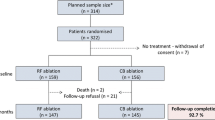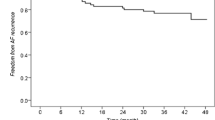Abstract
Purpose
We aimed to investigate the characteristics of focal atrial tachycardias (ATs) arising from the pulmonary veins (PVs), as well as the safety and long-term efficacy of cryoballoon (CB) versus radiofrequency (RF) ablation in this population.
Methods
Eighty-three patients with ATs arising from PVs from a consecutive series of 487 patients who underwent CB and RF ablation were retrospectively reviewed. Patients who had a prior history of atrial fibrillation (AF) were excluded. The AT origin was confirmed during the conventional electrophysiological study and activation mapping. The ablation approach was at the discretion of the operators.
Results
Thirty-five patients were managed with focal ablation, 25 were ablated with unilateral PV isolation (PVI), and the remaining 23 were performed with CB ablation. All procedures were successfully ablated. There was no significant difference in procedure time between CB group and RF focal group (43.7 ± 11.8 min vs. 45.8 ± 11.2 min, P = 0.121), whereas the fluoroscopy time in CB group was longer than in RF PVI group (10.1 ± 2.5 min vs. 8.4 ± 2.8 min, P < 0.001). There was 1 recurrence in CB group, 4 recurrences of AT in RF focal group, and 2 recurrence in RF PVI group (P = 0.643). Repeat ablation was performed in 6 of 7 patients. Seventy-eight patients were available for long-term follow-up. At a mean of 5.4 ± 4.6-year follow-up, 77 of 78 patients were free from AT without antiarrhythmic medication after 1.1 ± 0.3 procedures. No patient had procedural complications and developed AF during the follow-up period.
Conclusions
CB ablation is an effective and safe tool to treat ATs originating from the PVs. The ATs originating from the PVs represent an isolated clinical process and are not likely to be the forerunner of a more diffuse process leading to the development of PV AF.



Similar content being viewed by others
References
Kalman JM, Olgin JE, Karch MR, et al. “Cristal tachycardias”: origin of right atrial tachycardias from the crista terminalis identified by intracardiac echocardiography. J Am Coll Cardiol. 1998;31:451–9.
Kistler PM, Roberts-Thomson KC, Haqqani HM, et al. P-wave morphology in focal atrial tachycardia: development of an algorithm to predict the anatomic site of origin. J Am Coll Cardiol. 2006;48:1010–7.
Chen SA, Tai CT, Chiang CE, et al. Focal atrial tachycardia: reanalysis of the clinical and electrophysiologic characteristics and prediction of successful radiofrequency ablation. J Cardiovasc Electrophysiol. 1998;9:355–65.
Kistler PM, Sanders P, Fynn SP, et al. Electrophysiological and electrocardiographic characteristics of focal atrial tachycardia originating from the pulmonary veins: acute and long-term outcomes of radiofrequency ablation. Circulation. 2003;108:1968–75.
Baranowski B, Wazni O, Lindsay B, et al. Focal ablation versus single vein isolation for atrial tachycardia originating from a pulmonary vein. Pacing Clin Electrophysiol. 2010;33:776–83.
Teh AW, Kalman JM, Medi C, et al. Long-term outcome following successful catheter ablation of atrial tachycardia originating from the pulmonary veins: absence of late atrial fibrillation. J Cardiovasc Electrophysiol. 2010;21:747–50.
Kuck KH, Brugada J, Furnkranz A, et al. Cryoballoon or radiofrequency ablation for paroxysmal atrial fibrillation. N Engl J Med. 2016;374:2235–45.
Jensen-Urstad M, Bastani H, Braunschweig F, et al. Cryoballoon ablation: a novel technique for treating focal atrial tachycardias from the pulmonary veins. Europace. 2009;11:1445–7.
Saoudi N, Cosio F, Waldo A, et al. A classification of atrial flutter and regular atrial tachycardia according to electrophysiological mechanisms and anatomical bases; a Statement from a Joint Expert Group from The Working Group of Arrhythmias of the European Society of Cardiology and the North American Society of Pacing and Electrophysiology. Eur Heart J. 2001;22:1162–82.
Kistler PM, Sanders P, Hussin A, et al. Focal atrial tachycardia arising from the mitral annulus: electrocardiographic and electrophysiologic characterization. J Am Coll Cardiol. 2003;41:2212–9.
Tada H, Kaseno K, Kubota S, et al. Swallowing-induced atrial tachyarrhythmias: prevalence, characteristics, and the results of the radiofrequency catheter ablation. Pacing Clin Electrophysiol. 2007;30:1224–32.
Tang CW, Scheinman MM, Van Hare GF, et al. Use of P wave configuration during atrial tachycardia to predict site of origin. J Am Coll Cardiol. 1995;26:1315–24.
Yamane T, Shah DC, Peng JT, et al. Morphological characteristics of P waves during selective pulmonary vein pacing. J Am Coll Cardiol. 2001;38:1505–10.
Oral H, Ozaydin M, Tada H, et al. Mechanistic significance of intermittent pulmonary vein tachycardia in patients with atrial fibrillation. J Cardiovasc Electrophysiol. 2002;13:645–50.
Haissaguerre M, Jais P, Shah DC, et al. Spontaneous initiation of atrial fibrillation by ectopic beats originating in the pulmonary veins. N Engl J Med. 1998;339:659–66.
Khoueiry Z, Albenque JP, Providencia R, et al. Outcomes after cryoablation vs. radiofrequency in patients with paroxysmal atrial fibrillation: impact of pulmonary veins anatomy. Europace. 2016;18:1343–51.
Cardoso R, Mendirichaga R, Fernandes G, et al. Cryoballoon versus radiofrequency catheter ablation in atrial fibrillation: a meta-analysis. J Cardiovasc Electrophysiol. 2016;27:1151–9.
Avitall B, Urboniene D, Rozmus G, et al. New cryotechnology for electrical isolation of the pulmonary veins. J Cardiovasc Electrophysiol. 2003;14:281–6.
Gaita F, Leclercq JF, Schumacher B, et al. Incidence of silent cerebral thromboembolic lesions after atrial fibrillation ablation may change according to technology used: comparison of irrigated radiofrequency, multipolar nonirrigated catheter and cryoballoon. J Cardiovasc Electrophysiol. 2011;22:961–8.
Kenigsberg DN, Martin N, Lim HW, et al. Quantification of the cryoablation zone demarcated by pre- and postprocedural electroanatomic mapping in patients with atrial fibrillation using the 28-mm second-generation cryoballoon. Heart Rhythm. 2015;12:283–90.
Funding
This work was funded by a grant of the National Natural Science Foundation of China (#81670309).
Author information
Authors and Affiliations
Corresponding author
Ethics declarations
The research protocol used in this study was reviewed and approved by the institutional review board of the Fuwai Hospital.
Conflict of interest
The authors declare that they have no conflict of interest.
Additional information
Publisher’s Note
Springer Nature remains neutral with regard to jurisdictional claims in published maps and institutional affiliations.
Rights and permissions
About this article
Cite this article
Wei, HQ., Guo, XG., Zhou, GB. et al. Long-term outcome of cryoballoon ablation versus radiofrequency ablation for focal atrial tachycardias originating from the pulmonary veins. J Interv Card Electrophysiol 56, 271–278 (2019). https://doi.org/10.1007/s10840-019-00507-0
Received:
Accepted:
Published:
Issue Date:
DOI: https://doi.org/10.1007/s10840-019-00507-0




